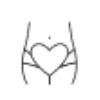If we’ve learned anything about fashion, it’s that it’s cyclical. From head to toe, styles are constantly changing. Pubic hair styles are no different, and they’ve definitely gone through a few notable stages over the decades.
Knowing the history of pubic hair styles and what’s trending now is an interesting glimpse into how we relate to our hair down there and can also show us just how far we’ve come.
What Has Been the Evolution of Pubic Hair?
The way we think about pubic hair is directly related to our culture. In the United States, we seem to have a serious love-hate relationship with our pubes.
Think about it — how much time and money have you spent trying to wax, shave, and shape your pubic hair over the years? Probably more than you think if you stop to add it up. How much of that was for you, and how much of that was for other people? No shame or judgment — we’ve all been there.
Although pubic hair is biological, it is also intrinsically connected to our sense of sexuality. What we have or don’t have downstairs can seriously impact our self-confidence level in the bedroom, for better or worse.
As public opinion on human sexuality changes and evolves (hopefully for the better), so do what we consider “acceptable” pubic hair styles. But we say wear it any way you want! If it works for your body and your life, who cares what anyone else says.
But to truly understand where we are now, we must look at our roots (pun intended). Let’s dive deep into the evolution of pubic hair and trace its origins to the pubic hair styles we’re rocking today.
Ancient Egyptians: Bare
Interestingly enough, the ancient Egyptians were big fans of a bare pubic area! Even though this was long before modern-day razors and wax salon set-ups, these sexual pioneers broke out the flints to remove not only their pubic hair but the hair all over their bodies.
Pubic hair was considered uncivilized, and even Cleopatra herself used an early waxing technique known as “sugaring” to make sure she stayed smooth. However, we can’t imagine how uncomfortable the process must have been without shaving cream or razor burn lotion. Talk about commitment.
However, not all ancient Egyptians subscribed to the same body standard. Some unearthed hieroglyphs showcased people with small triangles of pubic hair, showing that style rebels existed even back then. You go, Egypt!
Europeans of the Middle Ages: Leave It All On
On the flip side, Europeans in the Middle Ages (roughly from 500 - 1500 BC) mostly liked to leave their pubic hair untouched. Public opinion was that only sex workers removed their public hair, so a healthy, full bush was a sign of higher societal standing.
So much so that the first “merkin” made its appearance in 1450. If you’re unfamiliar with the term, a merkin is essentially a wig for the pubic area. Talk about a departure from ancient Egypt!
Much of the push to keep pubic hair had more to do with health and less with fashion. This wasn’t a particularly healthy period, so keeping your bush intact was thought to protect you from disease while also signifying sexual healthfulness.
Thankfully, doctors no longer check our pubic hair to diagnose our health and wellness.
Early 20th Century: Shave the Legs, Not the Bush
As pubic hair styles progressed through the years, so did technology! Gillette razors were first introduced to the world in 1901 and hit their stride in the early to mid-1900s.
Unfortunately, this was also when some of our modern opinions about female body hair were born. Razors were marketed mainly to those with female bodies to help them remove “unsightly” and “embarrassing” armpit and leg hair.
It wasn’t until the mid-1940s, when the bikini bathing suit made its debut, that razor advertising pivoted to pubic hair removal. After all, with swimsuits getting smaller and smaller, selling a trimmer to help remove the hair around the bikini line just made good business sense.
The Sixties and Seventies: Embrace the Bush
The 1960s and 1970s were a time of sexual liberation, and the concept of letting your body be natural and free also extended into pubic hair. Most everyone, not just hippies, rocked a full bush and even felt confident showing off their underarm hair au naturel. We love to see it!
Trimming and shaving body hair was something best left to more conservative people who just didn’t “get it.” We can’t say enough good things about how influential these two decades were on so many parts of society.
Although it wasn’t perfect, we have innovators from this era to thank for helping push us forward on the journey to self-acceptance. Who knew something as simple as pubic hair could have such a significant impact?
The Eighties and Nineties: Neatly Trimmed
There probably wasn’t a time in history when pubic hair was more publicly debated than in the eighties and nineties. There was big-time pushback against pubic hair removal (often seen as unnecessary or even “creepy”), but it wasn’t considered attractive just to let it grow wild and free as you could a decade or two before.
Thanks to magazines like Hustler and Playboy, female bodies were scrutinized and pressured to take their pubic hair grooming to a new level. Enter the dawn of pubic hair designs, like the landing strip.
People in the eighties and nineties spent more money than ever before on shaping their bush into something socially acceptable, but that target was constantly changing. Talk about a lose-lose situation.
Present Day: Anything Goes
The early 2000s were all about the Brazilian wax — a hair removal technique to remove all pubic hair. Waxing salons became extremely popular, and Brazilians were the quickest way to ensure no stray hairs popped out of the super-low-rise jeans that were in fashion at the time. Let’s just hope that trend stays gone.
But that wasn’t the only trend that the early 2000s ushered in. Where were you the first time you heard of vajazzling?
Vajazzling is one of history's most unique pubic hair trends, using crystals, glitter, and other sparkly objects to turn the pubes into an art project. Unfortunately, many vajazzle attempts ended with infections and even skin burns, especially when attempted at home.
As the years have passed, we’ve thankfully gotten to a place where anything goes. Pubic hair styles are accepted as another way to express who you are.
Some people like to remove all of their pubic hair, while others just trim or leave it entirely natural. What you do with your pubic hair is up to you, and anyone who shames you for it doesn’t deserve to take a peek.
Takeaway
If you have whiplash from reading about all the changes pubic hair styles have gone through, you’re not alone! While it may make you feel some type of way, don’t feel any pressure to conform.
Trends will come and go; it’s far more important that you feel comfortable with yourself and your body. If you’ve been feeling disconnected from yourself, try vulva mapping or take the time to draw yourself a bath and explore yourself. Once you learn to love yourself and accept your body for the piece of art it is, everything else will fall into place.
Sources:
Male preference for female pubic hair: an evolutionary view | PubMed
Middle Ages | Definition, Dates, Characteristics, & Facts | Britannica
What You Should Know About Getting a Brazilian Wax | Cleveland Clinic
Want more? Sign up for our newsletter
By entering your email, you are agreeing to our terms and conditions and understand our privacy policy.








